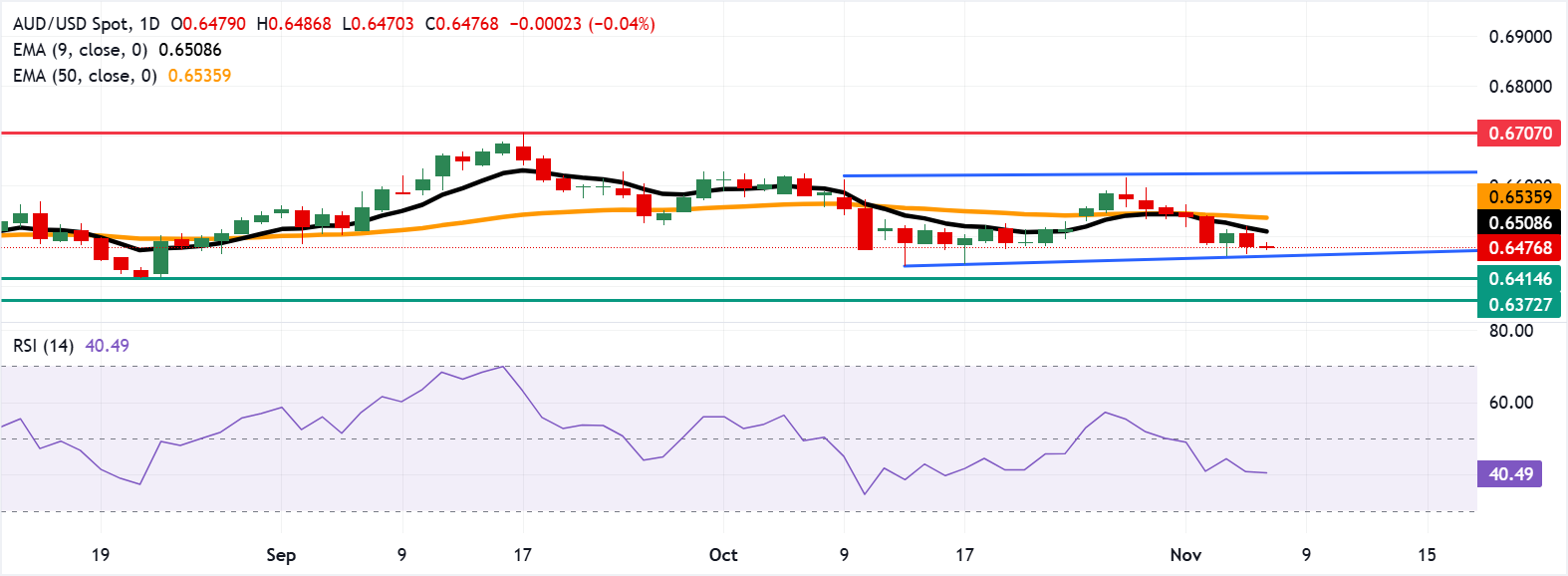Australian Dollar inches lower ahead of China’s Trade Balance data
- Gold Price Forecast: XAU/USD tumbles to near $3,950 on Fed's hawkish comments, trade optimism
- Gold drifts higher amid growing concerns over US government shutdown
- XRP, BNB, and SOL record major losses as Bitcoin slides to $105,000
- Goldman Sachs and Morgan Stanley warn of potential 20% market decline
- Bitcoin Stalls Below $110,000 as Miners Step In to Sell
- Forex Today: US Dollar clings to weekly gains as central bank dust settles

Australian Dollar moves little as traders adopt caution ahead of China’s Trade Balance data release.
The AUD may strengthen as Washington moves to suspend penalties on China’s shipbuilding sector.
The US Dollar may face challenges amid decreasing odds of a Fed rate cut in December.
Australian Dollar (AUD) declines against the US Dollar (USD) on Friday, extending its losses for the second successive session. The AUD/USD pair remains weaker ahead of China’s Trade Balance data due later in the day.
The AUD could receive support as Washington plans to halt penalties on China’s shipbuilding sector. The Office of the United States (US) Trade Representative announced that it is seeking public input on a one-year suspension of tariffs on Chinese imports.
China’s Finance Ministry announced on Wednesday that it will lift some tariffs on US agricultural products starting November 10. The ministry also said that the 24% tariffs on certain US goods will be suspended for one year, while the 10% tariffs will remain in place. Any change in the Chinese economy could impact the AUD as China is a major trading partner for Australia.
Australia’s Trade Surplus widened to 3,938 million month-over-month (MoM) in September, exceeding the 3,850 million expected and 1,111 million (revised from 1,825 million) in the previous reading. Exports rose by 7.9% MoM in September, swinging from a previous decline of 8.7% (revised from -7.8%). Meanwhile, Imports rose by 1.1% MoM, compared to a previous rise of 3.3% (revised from 3.2%).
US Dollar moves little after posting losses amid fading Fed rate cut bets
The US Dollar Index (DXY), which measures the value of the US Dollar against six major currencies, is holding ground after losing nearly 0.5% and trading around 99.80 at the time of writing.
The Challenger report showed that companies cut over 150,000 jobs in October, marking the biggest reduction for the month in more than 20 years. The announcement prompted the Federal Reserve (Fed) to lower interest rates at its December meeting
ADP Employment Change in the US climbed by 42,000 in October, compared to the 29,000 decrease (revised from -32,000) seen in September. This figure came in better than the estimations of 25,000. US ISM Services PMI climbed to 52.4 in October, from 50.0 prior and exceeding analysts’ forecasts of 50.8.
Fed Chair Jerome Powell signaled a more cautious approach, waiting for more data, which is complicated by the US government shutdown. Powell said that another rate cut in December is far from certain. However, Fed Governor Stephen Miran suggested that another rate cut could be appropriate in December.
The US government impasse has now entered its sixth week and is poised to become the longest federal funding lapse in US history after the Senate once again failed to pass a short-term funding bill. The most recent attempt to resolve the standoff, Republican-backed temporary legislation, was rejected by the Senate for the 14th time on Tuesday.
The White House announced on Tuesday that China will suspend extra export controls on rare earths and end probes into US semiconductor firms, in exchange for the US pausing some tariffs and canceling a planned 100% levy on Chinese exports.
US President Donald Trump announced a cut to fentanyl-related tariffs on imports from China, lowering the rate from 20% to 10%, and the continued freeze of some of his reciprocal levies on Chinese goods. The moves will go into effect on November 10, per Bloomberg.
China's RatingDog Services Purchasing Managers' Index (PMI) fell to 52.6 in October from 52.9 in September. The data matched the market forecast of 52.6 in the reported period. Manufacturing PMI declined to 50.6 in October from 51.2 in September. The market forecast was for a 50.9 print. It is important to note that any shift in China’s economic conditions could also affect the Australian dollar (AUD), given the close trade ties between China and Australia.
The S&P Global Australia Services PMI climbed to 52.5 in October from 52.4 in September, signaling continued growth in services activity and extending the expansion streak to 21 months. Meanwhile, Composite PMI came in at 52.1, down from 52.4 prior.
The Reserve Bank of Australia (RBA) decided to maintain the Official Cash Rate (OCR) at 3.6% in the November policy meeting on Tuesday. RBA Governor Michele Bullock said in her post-meeting press conference that policymakers had not discussed rate cuts and emphasized that annual core inflation remaining above 3% is undesirable. Bullock noted that the effects of previous rate cuts are still filtering through the economy. She added that policymakers discussed maintaining a cautious approach regarding the policy outlook.
Australian Dollar breaks below 0.6500 to target lower rectangle boundary
AUD/USD is trading around 0.6470 on Friday. Technical analysis of the daily chart shows the pair consolidating within a rectangle pattern, trading sideways. It remains below the nine-day Exponential Moving Average (EMA), indicating a weaker short-term momentum.
The AUD/USD pair may test the lower boundary of the rectangle around 0.6460, followed by the five-month low of 0.6414, which was recorded on August 21. Further support lies at the six-month low at 0.6372.
On the upside, the initial barrier lies at the nine-day Exponential Moving Average (EMA) of 0.6508, followed by the 50-day EMA at 0.6535. A break above these levels would improve the short- and medium-term price momentum and support the AUD/USD pair to explore the region around the rectangle’s upper boundary around 0.6630. Further advances would support the pair to approach the 13-month high of 0.6707, recorded on September 17.

Australian Dollar Price Today
The table below shows the percentage change of Australian Dollar (AUD) against listed major currencies today. Australian Dollar was the weakest against the US Dollar.

The heat map shows percentage changes of major currencies against each other. The base currency is picked from the left column, while the quote currency is picked from the top row. For example, if you pick the Australian Dollar from the left column and move along the horizontal line to the US Dollar, the percentage change displayed in the box will represent AUD (base)/USD (quote).
Read more
* The content presented above, whether from a third party or not, is considered as general advice only. This article should not be construed as containing investment advice, investment recommendations, an offer of or solicitation for any transactions in financial instruments.


